Every summer, my wife’s family rents a place on Cape Cod. We pack up the kids and join her family for a wonderful week of beach and sun. Without fail, my daughter will spend the first day combing the beach outside our door for beautiful shells, rocks, and inevitably hermit crabs.
She has so fallen in love with the little creatures that we decided to look into having one as a pet. Here’s what we found out.
How do you care for a hermit crab?
Hermit crabs, as simple as they appear, are complex creatures that require very specific habitats and food to live. You must give them a warm, humid environment. You must provide access to both salt and freshwater. You must provide deep damp sand. You should adopt more than one of them.
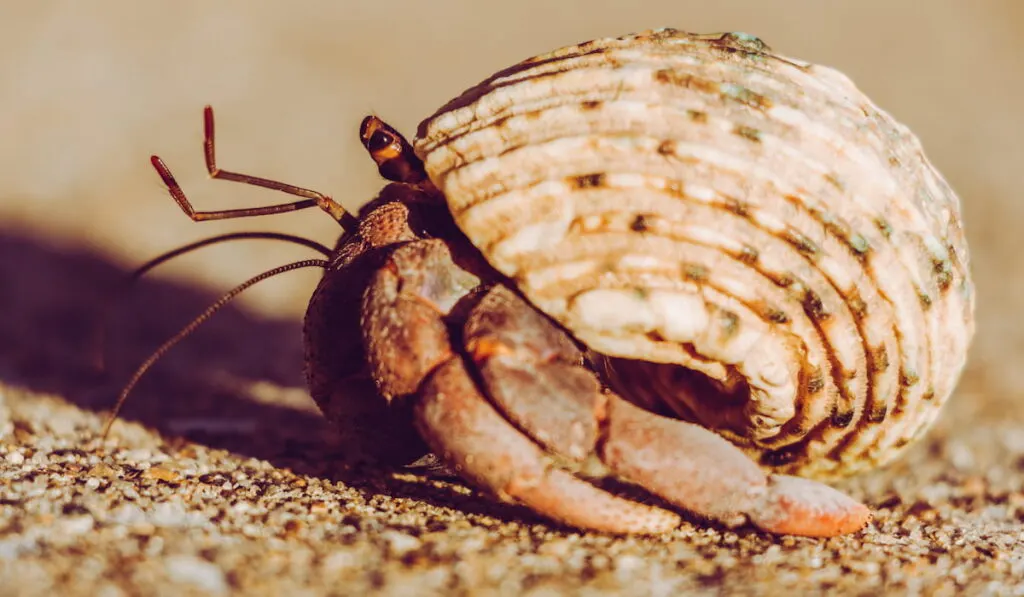
It is important that you understand what a hermit crab is and how they live in their normal habitat before you decide to adopt. It is a much bigger undertaking than most people realize.
Here is a complete guide on how to care for a hermit crab so you can make the right decision and give your hermit crab the life it deserves.
Table of Contents
The Tank for a Hermit Crab
The first and probably the most important thing to set up is the tank in which your hermit crab will be living.
Hermit crabs need very specific conditions to survive and picking out the right tank is key to mimicking these conditions.
Once you know what you need, the local pet store can find you all the right stuff.
The right tank should be:
- At least 5 gallons per crab: This is the very minimum. Some sites will tell you it needs to be 10 gallons per crab. The size of the tank really depends on the size of your crab and how many crabs you have.
- Solid Walls: Because you are going to have to control the temp and humidity, the wire cages you see in some pet stores will not work. Plastic is fine, but glass is the best choice for your crab.
- Metal Mesh Top: Mesh because your crab is going to need air. Metal because you are going to need a heat lamp.
Hermit Crab Tank Size Chart
| Crab Size | Tank Size per Crab | Minimum Substrate Depth |
| 2 Inches | 1 Gallon | 4 Inches |
| 2.5 Inches | 2.5 Gallons | 5 Inches |
| 3 Inches | 4 Gallons | 6 Inches |
| 4 Inches | 5.5 Gallons | 8 Inches |
| 5 Inches | 6.5 Gallons | 10 Inches |
| 6 Inches | 15 Gallons | 12 Inches |
Most hermit crabs are going to reach a maximum of six inches in captivity, and it takes them a while to get there.
Remember that these substrate depths are minimums. If you have a big enough tank, you can give them more substrate.
Keep in mind substrate depth when you are purchasing your tank. While it may seem like a short tank will due, you need to be sure that there is enough height available for the substrate and any tank decor and hides you may want to include.
Hermit Crab Temperature Preference
Hermit crabs live in warm environments, and if they are going to survive in your home, you will need to replicate that for them. But at the same time, crabs are cold-blooded, which means they cannot regulate their own temperatures.
Your tank will need a cool area as well, so the crab can lower its temperature if it gets too hot. Allow them a place to bask in the warm air and then make sure you keep an area there your hermit crab can relax.
Your tank is going to have to maintain a temperature of at least 75 degrees Fahrenheit (source).
You probably don’t want to let the temperature get over 85 degrees Fahrenheit because crabs can overheat when exposed to temperatures that high (source).
To maintain the proper temperatures for your crab, you will need it:
- Two thermometers: You need to know what the temperature is so you can regulate it, and that is what a thermometer is for. You are going to need at least two because you want to make sure there is a temperature gradient.
- Heat lamp: The best way to maintain the 75 degrees Fahrenheit that your crab needs is with a heat lamp. Pet stores sell reptile heat lamps that will work perfectly for your crab. If you don’t want to use a heat lamp, you can use under tank heaters instead.
- Lamp fixtures: There are many ways to hang your heat lamp. Again, most are sold at your local pet store. There are clips, domes, and hoods. Pick out whichever works best for you.
Remember, if you are using a heat lamp, you only want to heat one portion of the tank, so the crab has a region to go for cooling down.
Humidity
You also want to keep the humidity of the tank between 70% and 80%. Crabs breathe through modified gills, not lungs, so they need moisture in the air, or they will die.
If the humidity of the tank gets to 85%, it will bother the crab, they will be fine, but it will promote mold and bacteria growth as well as cause unwanted condensation on the tank walls.
To maintain these levels, you will need:
| Hand mister | You can boost the humidity briefly by spraying down the tank, but this tends to only last a few hours. |
| Hygrometer: | This measures the humidity of the tank. There are both analog and digital hygrometers. Either will work fine, although the digital ones tend to be more accurate and easier to read. |
| Covering your lid | If you have a mesh lid, or if there are gaps with your glass or aquarium hoods, moisture is being allowed to escape. You can cover your lid with plastic wrap or plexiglass to trap the moisture, but make sure to leave some gaps for air to get through. |
| Wet substrate | You should not soak the substrate, but you do need to make sure it stays moist. If the substrate is dry, the air is as well. Picking the right materials to make up your substrate can help. |
| Wide water dishes | The bigger the surface area of your water dishes, the more humidity that will be created. |
| Natural moss | Moss will create humidity in your tank and create a fun play area for your crab. Hermit crabs love moss! Just make sure the moss you are adding hasn’t been sprayed with pesticides. |
| Humidifier | Just like the ones you use in your room; these pump moist air into the tank. |
| Something To Add Moisture | you live in a climate where the humidity is low or where a furnace is dry the air during the winter; you are going to need some way to add moisture to the air. You can do that with: |
Substrate
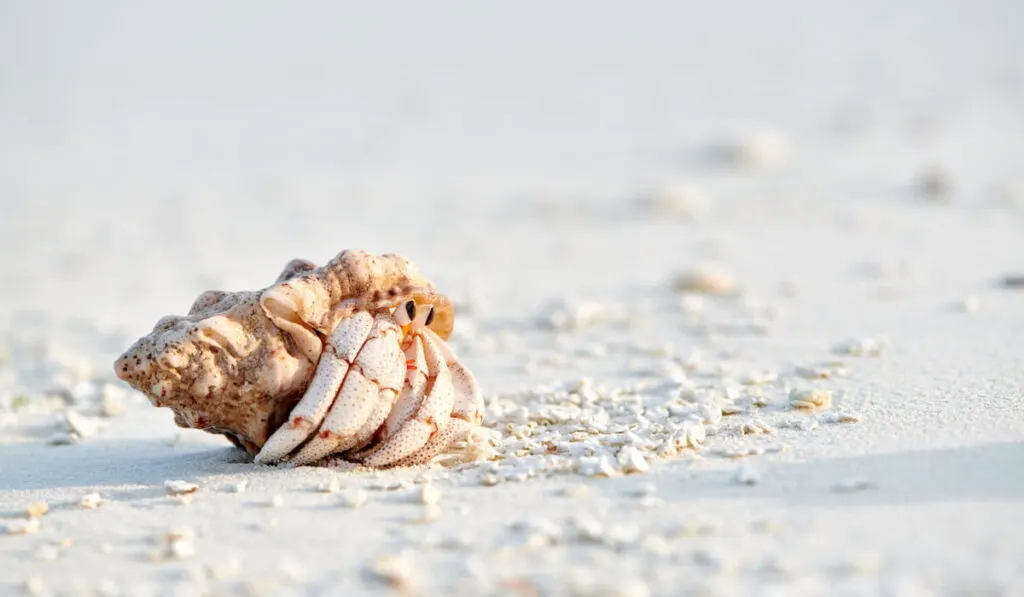
Most people do not realize how important substrate is to the hermit crab you have taken on as a pet. The right substrate is essential to the life cycle of hermit crab because they use it to help with molting.
Crabs shed their exoskeletons as they get bigger, creating new ones for their larger bodies.
To do this, hermit crabs bury themselves in the sand. If you don’t have the right substrate, this process will be affected, and their lives shortened.
There are three major choices for hermit crab substrate are:
- Sand: If you are going to use sand, your best bet is play sand from a hardware store. You will find special “hermit crab sand” at most pet stores, but that cannot always be trusted. Just make sure to bake the sand at 300 degrees Fahrenheit before you use it to make sure it is sanitized.
- Coconut Fiber: Also known as Forrest bedding or Eco-Earth. This is considered the best molting medium (source). When the crab digs a tunnel, if the tunnel collapses, it will not harm the crab as much since the coconut fiber is lighter than sand.
- Sand Coconut Mixture: The benefit to this is that it has more of the consistency of sand while doing a better job maintaining moisture.
Preparing Substrate
You need to prepare your substrate for your hermit crab. You do this by wetting the substance you are using for the substrate. The goal is to turn the substrate into a sand-castle consistency. This is just perfect for the hermit crab.
The crab is going to want to tunnel in the sand, so it needs to be moist enough to hold and not collapse onto your crab.
Using salt water to form the substrate is best because it will help kill and prevent mildew and mold growth.
Make sure to spray the substrate on a regular basis to maintain the moisture. You should only spray with fresh water since salt does not evaporate.
Spraying with saltwater will only build more and more salt into your substrate, which is harmful to your crab .
Amount
Since the hermit crab is going to be using the substrate for both molting and play, you’re going to want to make sure that you have enough in the tank for these purposes.
The rule of thumb is the substrate needs to be twice as deep as your tallest crab is tall.
Molting
Several times a year, your crab is going to need to molt. When it is ready to do so, you may notice different behaviors, different eating patterns, and a dull color to their legs and claws. They will bury themselves in the substrate for several weeks or months to complete the process.
Do not bother them while they are molting, or you could kill the crab. As stressful as it may be for you not knowing what is going on, you must wait and be patient. Even if you start to smell something like rotting or ammonia, let the crab be.
It is possible for a crab to die during molting, but extremely unlikely. On the off chance that it has died, leaving it in your tank will not harm your tank or other crabs.
Tank Setup Video
If you are looking for a good video on tank setup, this is one I really liked that touches on all of the hermit crab stuff mentioned in here and looks GREAT!
Socialization
One thing many people do not know about hermit crabs is that they are highly social creatures. In the wild, they travel in packs of up to 100 other crabs. It is thought that the reason for this has to do with shells.
The more crabs in a pack, the more shells. Hermit crabs will trade-off shells. So, if a new shell is introduced, one crab will move in, while another crab will move to the shell that was left behind.
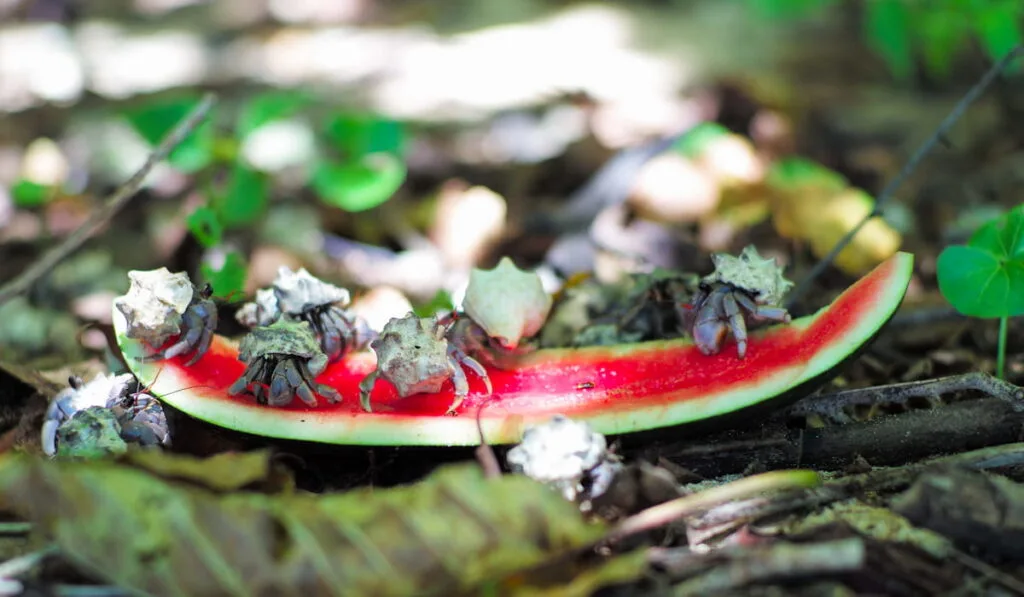
It is considered vital to the hermit crab’s survival that they have other crabs in the tank with them. So, don’t get just one hermit crab. The more you take on as pets, the better for their well-being.
Before putting a new crab into your tank, isolate it for at least a week to make sure it is healthy and happy.
When you introduce the new crab to your tank, monitor the crabs closely. Not all crabs will get along, and you may have to separate them if they begin to fight over shells.
Extra Shells
Hermit crabs are not that different from humans in that as they grow and age, they want to find a more spacious place to live.
Hermit crabs need to change shells as they grow and age. To help them with this process, you should leave extra shells in the tank.
The shells you leave around the tank should be of various sizes and should not be painted. If you do not leave a sufficient variety of shells, it may lead to fighting amongst the crabs for the best shells.
I really like this natural shell pack .
When selecting a new shell, a hermit crab goes through a series of steps:
- First, it explores the shell visually.
- It then starts to test the shell for movability.
- It will then try out the shell’s surface texture.
- The next thing it explores is the external shape of the shell
- Now it will test the opening to see if it can enter.
- It then makes sure the internal size is right.
- Lastly, it will turn the shell upside down to make sure it can right itself again (source).
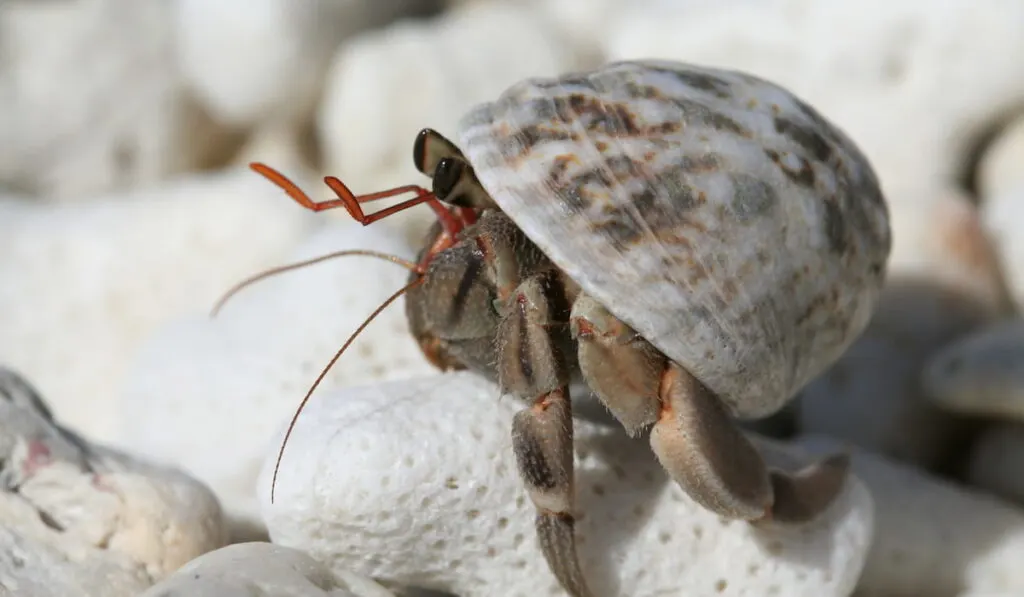
Drinking And Bathing Water
Any water that enters the tank needs to be treated with a de-chlorinator. If not, chlorine in the water will kill your hermit crab. Dechlorinators are sold at any pet store.
Since crab’s natural habitat is the seashore, you are going to have to provide both fresh and saltwater in the tank for your hermit crab. To do this, set up two dishes:
- One with fresh dechlorinated water
- One with dechlorinated water with marine aquarium salt added.
You can find the marine aquarium salt in the saltwater aquarium section of your pet store. Do not add table salt; it’s poisonous to hermit crabs.
The dishes should be deep enough for the crab to submerge but shallow enough for it to crawl out.
Hermit crabs need to replenish their shell water and clean out their shell. If you are unsure if your crab will be able to get out of your dishes, put in some rocks that it can use to climb out on.
Never use metal dishes. Hermit crabs are extremely sensitive to metals. Make sure to keep the dishes clean and change the water once a week.
You may want to add natural sea sponges to your water dishes. They will help regulate the humidity of the tank. The crabs will also press on them to get water to drink.
Feeding The Hermit Crab
In their natural habitat, hermit crabs are omnivorous scavengers that eat whatever they happen to come across. This means you can feed your crab almost anything.
There are commercial foods sold at pet stores, but the best choice for feeding is a varied diet of fruits, veggies, nuts, seeds, and unseasoned meats.
There are some foods that are toxic to hermit crabs. You should never feed your crab onions or spices like cinnamon or dill. Here is a list of foods that are good and a list of foods that are bad for your crab.
Toys
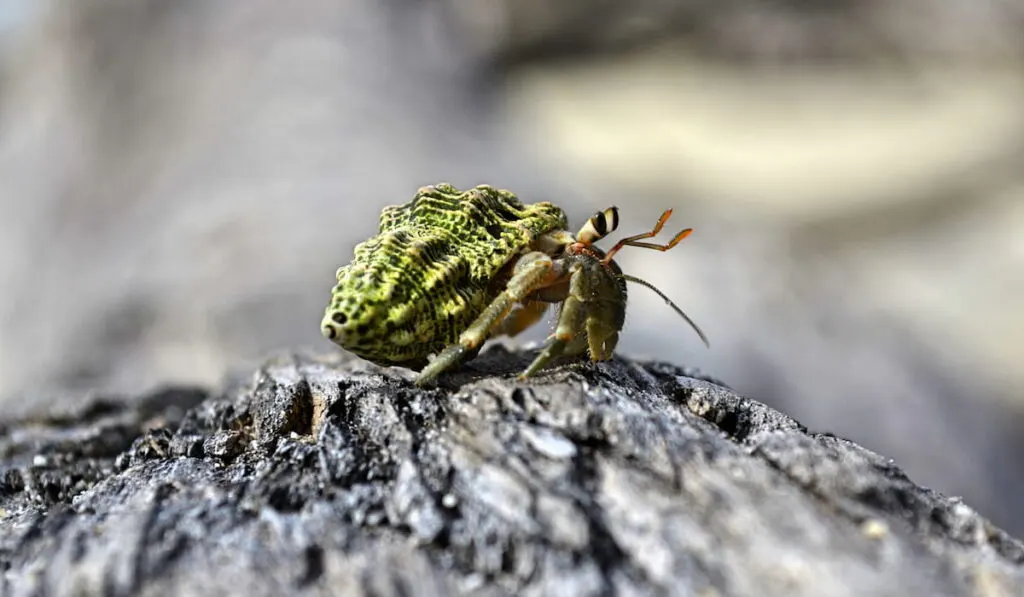
Hermit crabs love to play. It is one of the qualities that make them such interesting pets. It is important to fill your tank with plenty of toys for the crabs to enjoy. They will climb over and hide in almost anything you put in the tank. Some fun crab toys include:
- Dried choya wood. They will eat this too. This is my favorite one. Here is what it looks like.
- Research Choya Wood is helpful good in small habitats for the hermit crab to climb and chunk;
- It may well extensively utilized for reptiles and rodents;
- Natural aquarium decoration;
- Good climbing objects and decorative additions for hermit crabs;
- Your pet will just love climbing up on this choya wood log.
- Sand-blasted grapevine
- Driftwood
- Plastic plants
- Coral
- Clay flowerpots
- Legos (you can build all kinds of structures for them)
Any of these items can be easily found in pet stores or department stores. You may even have luck online. Try to change up the items you put in the tank to keep things fresh and exciting for your crabs.
You
Your hermit crab will like playing with you, too. You can take them out of their enclosure to have some one-on-one time with you. Just make sure you are in a safe place and there are no other pets around!
Summing up
They may be small, but with the right care and attention, hermit crabs can be the best pets you’ve ever had. Spend time with them, and you will learn about their quirky traits and fun personalities. Just make sure to follow these guidelines and your hermit crab experience is sure to be a fun one.
Resources:
- https://www.hermit-crabs.com/care.html
- http://www.plightofthehermies.org/adoption-and-care-guide/
- https://crabstreetjournal.org/
- https://nationalzoo.si.edu/animals/land-hermit-crab
- https://www.thesprucepets.com/hermit-crab-housing-1236872
- https://www.petsuppliesplus.com/Resource-Center/Reptile/Hermit-Crabs
